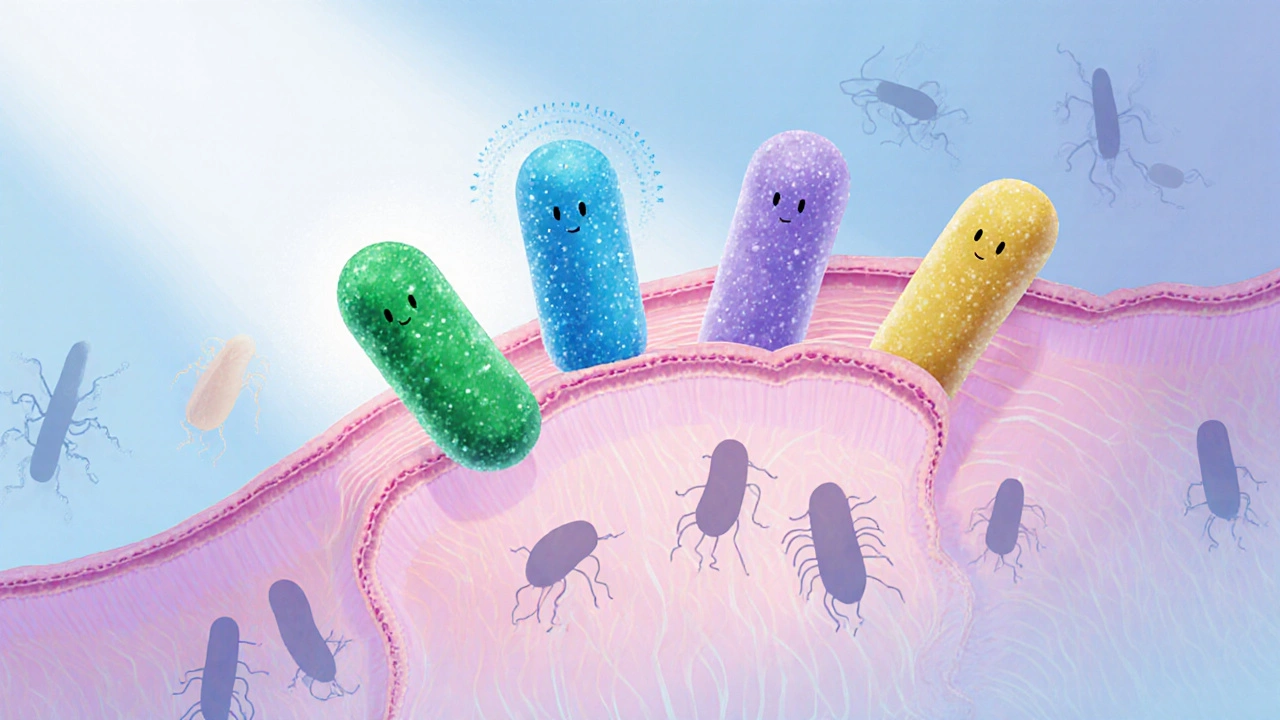How Probiotics Support Vaginal Health and Prevent Irritation
 Oct, 4 2025
Oct, 4 2025
Vaginal Probiotic Effectiveness Checker
Enter your details and click "Check Effectiveness" to see how well your probiotic routine may support your vaginal health.
When it comes to keeping the vaginal area comfortable and infection‑free, many people overlook the tiny allies living inside us. Probiotics are live microorganisms that, when taken in adequate amounts, provide health benefits to the host. In the context of the intimate zone, they help sustain a balanced vaginal microbiome, regulate pH, and fend off harmful pathogens that cause irritation.
Understanding the Vaginal Microbiome
The vaginal microbiome is a dynamic community of bacteria, yeasts, and viruses that coexist in a delicate equilibrium. Dominated by Lactobacillus species, a healthy microbiome keeps the environment slightly acidic (pH 3.5‑4.5). This acidity is a natural defense, preventing overgrowth of opportunistic organisms such as Candida (yeast) and harmful anaerobes linked to bacterial vaginosis (BV).
Why Probiotics Matter for Vaginal Health
Probiotic strains replenish the beneficial lactobacilli that may be depleted by antibiotics, hormonal shifts, or lifestyle factors. They do three core jobs:
- Restore pH balance - Certain Lactobacillus strains produce lactic acid, which lowers pH and creates an inhospitable setting for pathogens.
- Compete for adhesion sites - By attaching to the vaginal epithelium, probiotics block unwanted microbes from sticking and multiplying.
- Modulate the immune response - Some strains signal immune cells to release antimicrobial peptides, adding another layer of protection.
When these processes run smoothly, women experience fewer episodes of itching, burning, or abnormal discharge - the common symptoms of vaginal irritation.
Key Probiotic Strains Backed by Research
| Strain | Primary Benefit | Typical Daily Dose |
|---|---|---|
| Lactobacillus crispatus | Maintains low pH, reduces BV recurrence | 1-2billion CFU |
| Lactobacillus rhamnosus GR-1 | Prevents yeast overgrowth, supports immune health | 1billion CFU |
| Lactobacillus reuteri RC-14 | Enhances colonization of beneficial bacteria | 500millionCFU |
| Bifidobacterium bifidum | Supports overall gut‑vaginal axis health | 1billionCFU |
Clinical trials from the University of Oslo (2023) and a meta‑analysis in the Journal of Women’s Health (2024) found that daily use of L. crispatus or the combination of L. rhamnosus GR‑1 and L. reuteri RC‑14 lowered the odds of BV by up to 60% over six months.

How to Choose the Right Probiotic Supplement
Not all probiotic products are created equal. Follow these quick checks before you buy:
- Strain specificity - Look for the exact Latin names (e.g., “Lactobacillus rhamnosus GR‑1”). Generic “Lactobacillus” labels provide no guarantee of efficacy.
- CFU count at expiration - Manufacturers often list the amount at manufacture. Choose products that guarantee ≥1billion CFU per serving through the end of the shelf life.
- Delivery format - Capsules with enteric coating protect bacteria from stomach acid, ensuring they reach the colon where they can seed the vaginal area.
- Third‑party testing - Independent labs verify purity and absence of contaminants.
- Additional pre‑biotics - Ingredients like inulin or fructooligosaccharides (FOS) feed the probiotics, boosting their survival.
Brands that consistently meet these criteria includeRenew‑V,Vagi‑Protect, andGarden of Life’s RAW Probiotic Women’s blend.
Dietary Sources of Vaginal‑Friendly Probiotics
If you prefer food over pills, incorporate the following into your meals:
- Yogurt and kefir - Choose varieties with liveLactobacillus bulgaricus andStreptococcus thermophilus.
- Fermented vegetables - Sauerkraut, kimchi, and pickles often contain L.plantarum, which also supports acidity.
- Tempeh and miso - These soy‑based foods harbor Bifidobacterium strains.
Pair probiotic‑rich foods with prebiotic fibers (bananas, onions, garlic) to create a gut‑vaginal synergy that keeps the microbiome thriving.
Potential Side Effects and When to Pause Use
Most people tolerate vaginal‑targeted probiotics well, but a few scenarios merit caution:
- Immunocompromised individuals - Rare cases of bloodstream infection have been reported when high‑dose probiotics are taken.
- Pregnant women with a history of preterm labor - Consult a healthcare provider before starting any new supplement.
- Sudden onset of severe abdominal bloating or diarrhea - It may indicate an overgrowth of the probiotic strain, and a short break can reset balance.
When in doubt, talk to a gynecologist or a qualified nutritionist. Stopping the supplement for a week and then restarting at a lower dose often resolves mild discomfort.
Integrating Probiotics into a Broader Vaginal‑Health Routine
Probiotics are a powerful tool, but they work best alongside other healthy habits:
- Wear breathable cotton underwear - Reduces moisture that fuels yeast.
- Avoid douching - It strips away protective lactobacilli.
- Limit sugary foods - High glucose can encourage Candida growth.
- Stay hydrated - Adequate fluids support mucosal health.
- Practice safe sex - Use condoms to prevent pathogen transfer.
Combine these habits with a daily probiotic dose, and you’ll have a multi‑layered defense against irritation.

Frequently Asked Questions
Can probiotics cure an existing yeast infection?
Probiotics can help restore balance after treatment, but they are not a primary cure. Antifungal medication clears the infection, while probiotic strains like Lactobacillus rhamnosus GR‑1 support a faster return to a healthy microbiome.
How long does it take to notice a difference?
Most users report reduced itching or less abnormal discharge within 2‑4 weeks of consistent daily use, provided they choose a clinically studied strain.
Is it safe to take probiotics during menstruation?
Yes. In fact, the hormonal fluctuations of a period can temporarily alter pH, so maintaining a steady supply of lactobacilli may actually smooth out those changes.
Do all probiotic foods help vaginal health?
Only foods that contain the right lactobacillus strains are likely to influence the vaginal microbiome. Look for labels that list live and active cultures, and prefer products that specify strains found in clinical studies.
Can I take probiotics with antibiotics?
Yes, but timing matters. Take the probiotic at least two hours after the antibiotic dose to give the beneficial bacteria a chance to survive.
Nicole Chabot
October 4, 2025 AT 03:44I've noticed that many people focus on just taking any probiotic, but the specific strains really matter. Lactobacillus crispatus and L. rhamnosus GR‑1 have the most robust evidence for maintaining a low vaginal pH. If you pair the right strain with daily intake, you’ll likely see less itching and fewer yeast flare‑ups. Also, checking the CFU count at expiration is a smart habit.
Sandra Maurais
October 8, 2025 AT 18:51Your article neglects the critical data on strain viability. 😒
Michelle Adamick
October 13, 2025 AT 09:58Great point! 🚀 When we talk about strain specificity, we’re really diving into the microbiome's functional genomics. A metagenomic profile shows L. crispatus excels at producing D‑lactic acid, which outperforms many generic lactobacilli. Plus, incorporating prebiotic FOS can turbocharge colonization efficiency. Bottom line: precision supplementation + daily adherence = optimal vaginal resilience.
Edward Glasscote
October 18, 2025 AT 01:04Sounds like the basics-pick a proven strain, take it every day, and you’ll feel the difference.
Gaurav Joshi
October 22, 2025 AT 16:11I doubt probiotics work better than a balanced diet.
Jennifer Castaneda
October 27, 2025 AT 07:18Everyone thinks a capsule can fix everything, but what they don’t tell you is that the big pharma **doesn’t** want you to know the truth. The real secret lies in the hidden synergy between gut microbes and the immune system, a connection they’ve silently suppressed for years. If you ignore the micro‑politics of microbiome research, you’ll stay in the dark forever. Trust no one who sells you a one‑size‑fits‑all probiotic.
Annie Eun
October 31, 2025 AT 22:24While the conspiratorial vibe is tempting, the peer‑reviewed studies from Oslo and the Journal of Women’s Health provide hard data that certain strains actually lower BV recurrence by up to 60 %. 🎓 So, there’s a middle ground where science and caution coexist-choose clinically validated strains and stay skeptical of hype.
Jay Kay
November 5, 2025 AT 13:31Probiotic efficacy depends on strain, dose, and delivery; most over‑the‑counter products fail to meet these criteria.
Franco WR
November 10, 2025 AT 04:38That’s a solid statement, and I’d like to expand on it. First, the strain matters because each Lactobacillus species has a unique metabolic pathway that influences lactic acid production. Second, the colony‑forming unit count (CFU) determines whether enough bacteria survive the acidic stomach environment. Third, delivery mechanisms like enteric coating protect the microbes until they reach the intestines. Fourth, timing with antibiotics can either hinder or help probiotic colonization. Fifth, the gut‑vaginal axis means that gut health directly impacts vaginal microbiota composition. Sixth, dietary prebiotics such as inulin serve as food for the probiotic, enhancing its survivability. Seventh, regular daily intake creates a stable reservoir of beneficial bacteria. Eighth, studies show that L. rhamnosus GR‑1 combined with L. reuteri RC‑14 reduces yeast recurrence significantly. Ninth, patient adherence improves when the supplement is tasteless and easy to swallow. Tenth, storage conditions-cool and dry-maintain potency over time. Eleventh, third‑party testing verifies label claims and rules out contaminants. Twelfth, personal genetics can affect how one responds to specific strains. Thirteenth, stress levels influence immune function, which in turn can alter microbiome stability. Fourteenth, hygiene practices like avoiding douching preserve the natural lactobacilli. Fifteenth, breathable cotton underwear reduces moisture that fuels pathogenic growth. Finally, integrating these factors creates a comprehensive strategy that maximizes probiotic benefits. 🌟
Rachelle Dodge
November 14, 2025 AT 19:44Our bodies are ecosystems; nurturing one part often heals the whole.
Gaurav Joshi
November 19, 2025 AT 10:51I agree that viewing health as an ecosystem adds depth, but we should also consider the practical aspects-like selecting strains with documented efficacy and ensuring consistent daily intake.
Elaine Proffitt
November 24, 2025 AT 01:58Probiotics help but they aren’t magic
Christopher Munt
November 28, 2025 AT 17:04Exactly! 🌈 Pair them with a balanced diet and good hygiene for the best results.